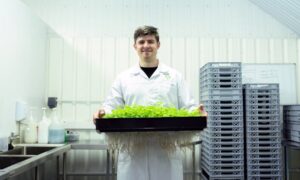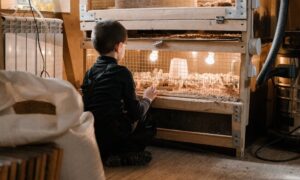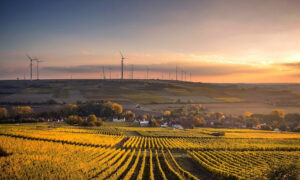You may not have heard of AppHarvest, but chances are you will before long. As the world’s population grows and its resources become more strained, large-scale solutions for sustainable farming are essential. It’s this world that AppHarvest is hoping to support— one where there’s enough food to go around—powered by cutting-edge technology and its benefits.
How is AppHarvest doing this? By building massive, sustainably operated indoor farms—supported by AI-driven, robotic harvesters.
“We believe that Planet Earth is the hidden gem of the known universe,” says Jonathan Webb, the Founder of AppHarvest. “I’m a huge believer that nature is the most technologically advanced thing we have on Planet Earth, and we need to harness it.”

The first-ever AppHarvest farm in Kentucky is bigger than 50 football fields and can produce about 40 million pounds of produce a year. That’s double the amount of produce grown in the entire country of Denmark. The tomato vines, which can grow up to 40 feet in height, are harvested by human crop care specialists and the company is now developing and testing “co-bots,” robots that work alongside their human counterparts. As the robots pick, they use AI to accurately identify different types of tomatoes and the degree of ripeness.
The timing is certainly ripe, er, right. Analysts predict food demand will grow exponentially in the coming decades, with the global population expected to rise to over 9 billion in the next 30 years. But the increase in the food supply is a major source of concern, as food requires a great deal of resources to produce.
AppHarvest believes it’s helping to provide potential solutions to create sustainable, climate-resilient food supplies. Their high-tech indoor farm, for example, uses only rainwater for irrigation, which almost eliminates its water consumption. By positioning the indoor farm in Kentucky, which is currently in the midst of its wettest decade on record, they’ve ensured that they’ll always have a consistent source of sustainable irrigation.
AppHarvest’s leadership believes that their “controlled environment agriculture” approach offers a range of long-term benefits. Collecting rainwater leads to up to 90% less water usage, and farming indoors means that plants can be grown year-round no matter the weather. The indoor farm approach also helps to protect plants against pests and insects, avoiding the need for harsh chemical pesticides. Finally, the greenhouse approach leads to higher yields—as much as 30 times more than traditional farming methods on the same amount of land.
So, what’s next for AppHarvest? Founder Jonathan Webb says it’s simple— more indoor farms. He plans to build a network of farms in Central Appalachia, bringing the high tech approach used in the existing facility to these new supermassive, high-tech greenhouses. In 2022, AppHarvest expects to expand to leafy greens and berries in addition to the tomatoes it’s currently growing.
This approach may seem ambitious, but according to scientists, it will ultimately be necessary to provide enough food for the planet. The United Nations estimates that to feed the 10 billion people we’re expected to have on Earth by 2050, we’ll need to increase food production by 70%. That means that for every 10 crops currently being grown, we’ll need to find the means and space to produce another 7—and we only have 30 years to do that.
It’s more than just a logistical problem. If we continue to use existing traditional farming methods, we’ll need to nearly double the amount of land that serves as farmland. Large-scale open farmland is notoriously bad for the environment, creating a monoculture ecosystem where native animal and plant life don’t have the resources or habitats they need to thrive. If we don’t come up with creative solutions, our mission to feed humanity will lead to us ultimately starving out the plants and animals with whom we share the planet.
So how do we meet the exponential rise in need for food production without decimating habitats and choking the planet of resources? According to entrepreneurs like Webb, the answer is changing the way we farm.
One surprising example? AppHarvest’s crops are grown without soil. A combination of water and essential nutrients is absorbed directly by the plant’s roots and creates an efficient, less resource-intensive food source for the crops.
The AI element is also promising, with the first AppHarvest facility using 300 unique sensors to collect data from over 700,000 plants. Growers can then remotely monitor these plants, their climates, and their growth cycle to make micro- and macro-adjustments in order to make crop yields more efficient and sustainable.
Time will tell if indoor farms save the world from being overused and its people underfed. There are other creative companies, scientists, and entrepreneurs working on creative solutions that may also serve to positively impact the way we grow food and interact with the planet’s limited resources. But one thing is for certain: if the world continues to function amid climate change and a rising population, AppHarvest’s creative solutions are going to be essential.



































